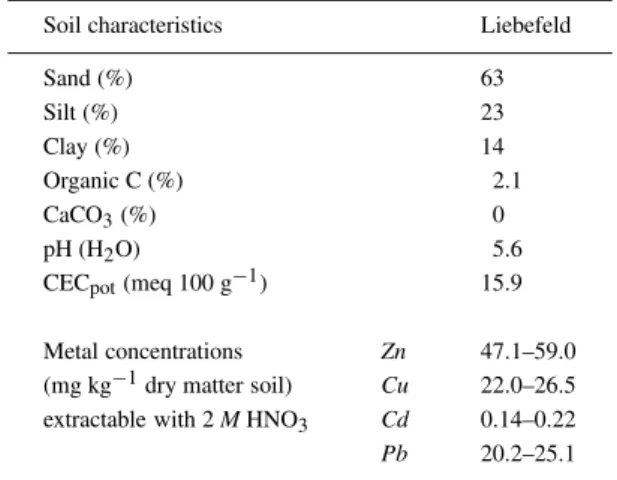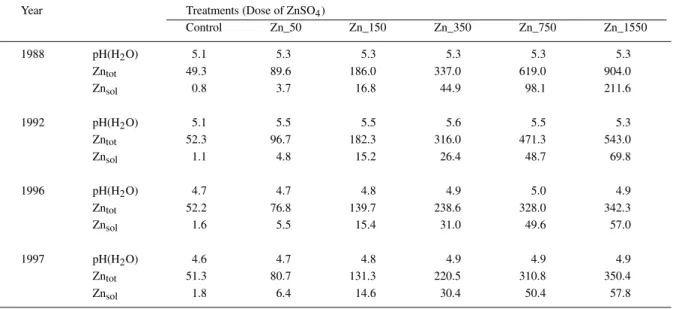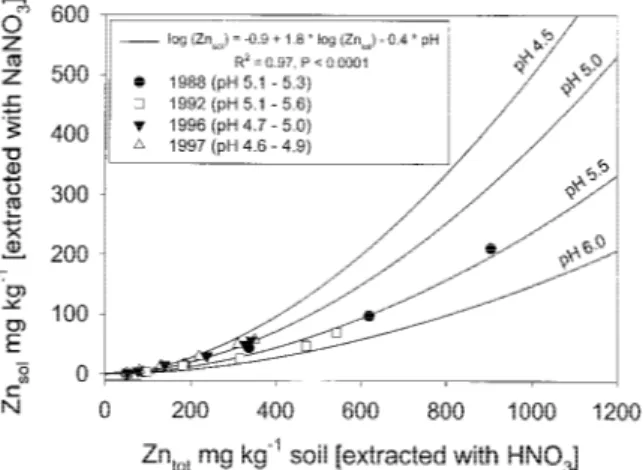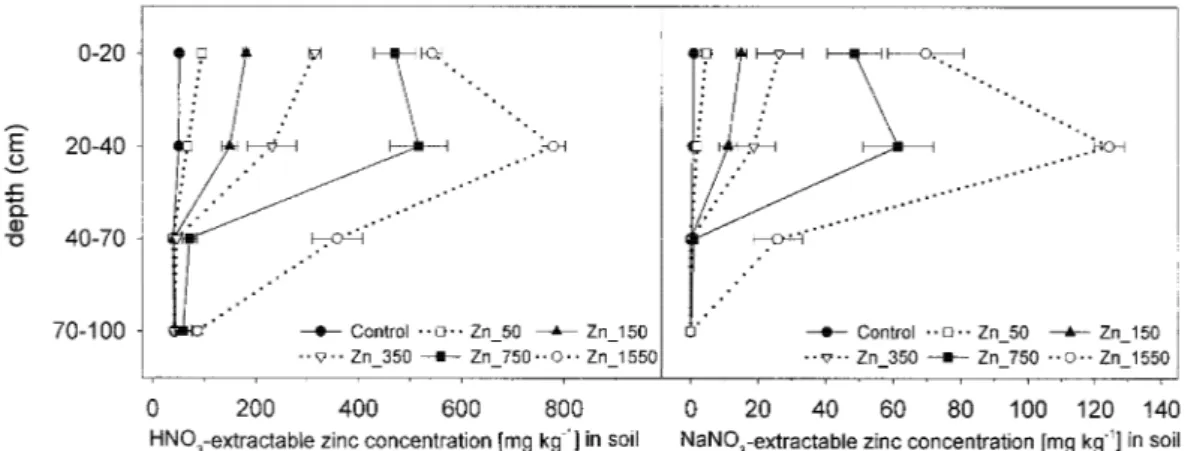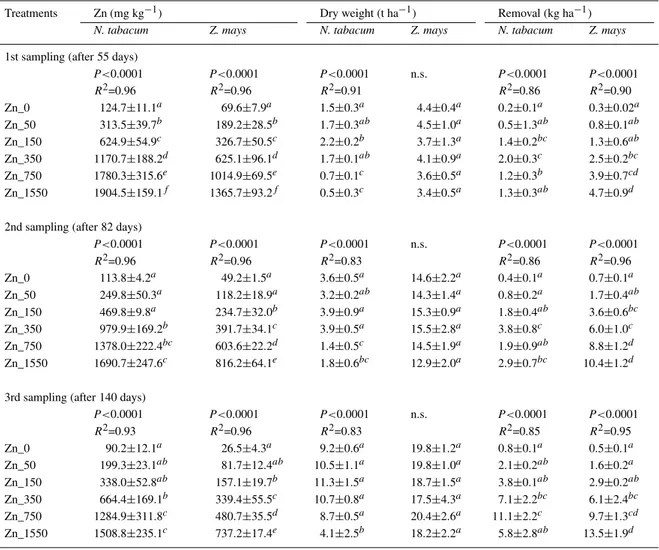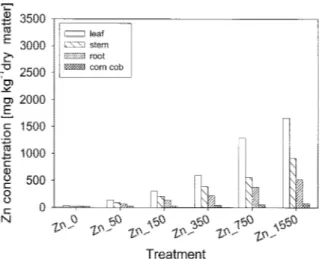© 2002 Kluwer Academic Publishers. Printed in the Netherlands. 217
Zinc Extraction potential of two common crop plants, Nicotiana tabacum
and Zea mays
K. Wenger
1,3, S. K. Gupta
1, G. Furrer
2& R. Schulin
21Swiss Federal Research Station for Agroecology and Agriculture, Liebefeld, Schwarzenburgstrasse 155, CH-3003 Bern, Switzerland. 2Institute of Terrestrial Ecology (ITO), ETH Zurich, Grabenstrasse 3, CH-8952 Schlieren, Switzerland. 3Corresponding author∗. Present address: Institute of Terrestrial Ecology (ITO), ETH Zurich, Grabenstrasse 3, CH-8952 Schlieren, Switzerland
Received 28 February 2001. Accepted in revised form 8 March 2002
Key words: Nicotiana tabacum, phytoextraction, soil contamination, Zea mays, zinc
Abstract
A field study was conducted to investigate the efficiency of Zn phytoextraction by Nicotiana tabacum and Zea mays from a soil that had been artificially contaminated by different amounts of ZnSO4(0, 50, 150, 350, 750 and
1550 mg kg−1soil) 10 years prior to the present cropping.
Increased NaNO3-extractable Zn in soil translated well into shoot concentrations (dry matter) in plants. Zn
uptake by Z. mays increased linearly with increasing NaNO3-extractable Zn in soil, while for N. tabacum the
increase could be described by a Langmuir isotherm. While Z. mays showed no significant decrease in biomass production up to the highest contamination level in soil, N. tabacum responded with a reduction of plant growth of about 50% compared with control plants at the highest Zn concentrations in soil. Maximum removal of Zn was 13 kg ha−1 y−1 with Z. mays and 11 kg ha−1 y−1 with N. tabacum. Calculated time required to reduce soil Zn from 350 to 150 mg kg−1 was about 55 years for N. tabacum and about 63 years for Z. mays at a soil pH of 4.8. At higher soil pH of 6.0 calculated decontamination time was about 87 years for N. tabacum and more than 200 years for Z. mays.
Only small amounts of Zn were translocated into the seeds of N. tabacum and cobs of Z. mays. Therefore, corn cobs of Z. mays could be safely used for fodder and the seeds of N. tabacum, which are rich in oil, for industrial purposes, e.g. in the paint industry.
Introduction
Zn is phytotoxic at high concentrations and reduces crop yields when plant leaves reach about 300–1000 µg Zn g−1dry mass (Chaney, 1993). Due to industrial galvanization and agricultural use as feed additive, Zn has been extensively dispersed, and has reached phyto-toxic concentrations in some areas. With decreasing soil pH, Zn becomes increasingly solubilized in the soil and available to plant uptake, enhancing the risk of phytotoxic effects (Chaney, 1993). Very severe growth disorders with yield reduction of more than
∗ FAX No: +41-1-633-11-23.
E-mail: wenger@ito.umnw.ethz.ch
50% for several crop plants were observed at a site in northern Switzerland where the soluble Zn (NaNO3
-extractable) contents in soil exceeded 20 µg g−1DW (Schmid and Wegelin, 1996). In the short run, devel-opment of plant production systems not affected by Zn phytotoxicity may be an option to make economic agricultural use of such soils. In the long run, however, decontamination is the more desirable alternative, in order to prevent the dispersal of the pollution and its transfer into food chains and water resources.
In recent years phytoextraction has been suggested by several authors as a ‘green’ and low-cost techno-logy to clean up metal polluted sites (Cunningham et al., 1995; Jørgensen, 1993; Kumar et al., 1995;
McGrath et al., 1993). This technique uses the abil-ity of certain plants to accumulate heavy metals in very high concentrations in their aboveground parts. Suitable plants for phytoextraction generally fall into two categories. The first are hyperaccumulators which show a very high foliar metal concentration but usually do not provide a high annual biomass production. The second category consists of plants that have a lower metal concentration but have a large biomass produc-tion so that the total metal removal may be even higher for these plants than for hyperaccumulators. Although most economic plants suffer significant yield reduc-tion when foliar Zn exceeds 500 µg g−1 DW, there are high biomass species such as oat (Avena sativa), tobacco (Nicotiana tabacum) or maize (Zea mays) that were known to accumulate higher amounts of heavy metals (Ebbs and Kochian, 1998; Mench et al., 1989; Wilcke and Metz, 1993).
Several studies conducted under greenhouse or growth chamber conditions indicate that metal extrac-tion by both the crop and hyperaccumulating species hold potential for removing metals from contaminated soil (Ebbs et al., 1997; Kumar et al, 1995; McGrath et al., 1993; Wilcke and Metz, 1993), but long-term ex-perience with phytoextraction under field conditions is still lacking. Only few allegedly successful full-scale field applications have been reported so far (Eden-space 2000; EPA, 2000). One of the crucial factors of the phytoextraction technology is the time required for an eventual site decontamination. One possibility to make longer time-periods in phytoremediation more acceptable could be the use of plants that accumulate metals and at the same time allow an economical use of at least some plant parts.
In this paper results are presented from a long-term field study, which was started in 1987 as the soil had been amended with different amounts of zinc sulphate. The long-term effects of these treatments on bioavail-able Zn in soil were monitored in 1988, 1992, 1996 and during the phytoextraction experiment in 1997. The objectives of this study were: (a) to examine the NaNO3extractability as an indicator of Zn
phytoavail-ability over time and in relation to soil pH, (b) to investigate the potential of two high yielding com-mon crop plants, Zea mays and Nicotiana tabacum, to remove Zn from contaminated soils, and (c) to de-temine the allocation of Zn within the two plants in order to find out if there were plant parts that remain economically usable.
Table 1. Soil properties
Soil characteristics Liebefeld
Sand (%) 63 Silt (%) 23 Clay (%) 14 Organic C (%) 2.1 CaCO3(%) 0 pH (H2O) 5.6
CECpot(meq 100 g−1) 15.9
Metal concentrations Zn 47.1–59.0 (mg kg−1dry matter soil) Cu 22.0–26.5 extractable with 2 M HNO3 Cd 0.14–0.22
Pb 20.2–25.1
Materials and methods
Site description and soil characterization
The field plots were located at the Swiss Federal Re-search Station of Agroecology in Liebefeld (Switzer-land), 565 m above sea level. Liebefeld has a temper-ate climtemper-ate, with a mean annual temperature of 7.7◦C and an average annual rainfall of 1000 mm. The soil was classified as an orthic luvisol (FAO taxonomy) of sandy loam texture. The Liebefeld soil is free of carbonate. Metal concentrations and other selected properties of the soil are given in Table 1.
Treatments and experimental design
In 1987, the experiment at the Liebefeld site was started. Eighteen field plots of 2.8×2.8 m were set up on an area with almost homogeneous metal con-tent (Table 1). The plots were treated with different amounts, 0, 50, 150, 350, 750 and 1550 mg kg−1 of zinc sulphate (ZnSO·47H2O), each on three replicates.
Zinc sulphate was added in powder form to the soil surface and worked 20 cm deep into the soil. In the following we refer to the treatments with zinc sulphate as Zn_0 (Control), Zn_50, Zn_150, Zn_350, Zn_750 and Zn_1550, respectively, according to the amounts of added Zn.
In 1997, each plot was subdivided into two sub-plots (1.4×2.8 m) and on half of each field plot Zea mays (cv. LG11) and Nicotiana tabacum (cv. Badis-cher Geudertheimer) were grown. Fertilization was carried out according to the recommendations of the Swiss Federal Research Stations (Walther et al., 1994).
Table 2. ‘Total’ (HNO3-extraction) and ‘soluble’ (NaNO3-extraction) Zn in topsoil (0–20 cm) and soil pH 1, 5, 9 and 10 years after
contamination (1987), depending on the applied ZnSO4dose
Year Treatments (Dose of ZnSO4)
Control Zn_50 Zn_150 Zn_350 Zn_750 Zn_1550 1988 pH(H2O) 5.1 5.3 5.3 5.3 5.3 5.3 Zntot 49.3 89.6 186.0 337.0 619.0 904.0 Znsol 0.8 3.7 16.8 44.9 98.1 211.6 1992 pH(H2O) 5.1 5.5 5.5 5.6 5.5 5.3 Zntot 52.3 96.7 182.3 316.0 471.3 543.0 Znsol 1.1 4.8 15.2 26.4 48.7 69.8 1996 pH(H2O) 4.7 4.7 4.8 4.9 5.0 4.9 Zntot 52.2 76.8 139.7 238.6 328.0 342.3 Znsol 1.6 5.5 15.4 31.0 49.6 57.0 1997 pH(H2O) 4.6 4.7 4.8 4.9 4.9 4.9 Zntot 51.3 80.7 131.3 220.5 310.8 350.4 Znsol 1.8 6.4 14.6 30.4 50.4 57.8
Sample collection and analysis
Soil samples from the topsoil (0–20 cm depth) had been collected from each plot in 1988, 1996 and 1997. In 1992, soil samples from the topsoil (0–20 cm depth) and the subsoil (20–40 cm, 40–70 cm and 70–100 cm) had been collected from each plot.
In 1997 plant samples were taken at random at different plant growth stages (in July after 55 days, in August after 82 days and in October after 138 days just before harvest), three from each subplot and merged to one mixed aboveground plant sample per subplot, respectively. In October whole plants inclus-ive roots were sampled and then divided into roots, stems, leaves and corn cobs or N. tabacum seeds, re-spectively. At the harvest (after 140 days), all aerial parts of the N. tabacum and Z. mays plants were col-lected and cleansed, coarsely ground, and weighed (total fresh weight). After homogenization, approxim-ately 500 g were collected from each subplot sample. The plants and plant parts were dried at 70◦C to con-stant weight. The oven-dried material was then finely ground in a titanium mill. A subsample of this material was dried at 105◦C to eliminate residual water, and weighed again for biomass calculations. At each plant sampling time, soil samples from the topsoil (0–20 cm depth) were collected as well.
Soil samples were analyzed for pH and for NaNO3- and HNO3-extractable metal concentrations.
HNO3-extractable metals were referred to as ‘total’
metal concentrations in the following, although a re-sidual fraction is left in the soil with HNO3extraction.
However, we considered this residual fraction to be very small (<5%) in our artificially contaminated soil and not relevant for plant uptake anyway. ‘Total’ heavy metals were determined by extraction with 2 M HNO3
with a soil to solution ratio of 1:10. Suspensions were heated for 2 h in a boiling water bath. NaNO3
ex-tractable metals were referred to as ‘soluble’ metal concentrations in the following and were determined by extraction with 0.1 M NaNO3 with a soil to
solu-tion ratio of 1:2.5. The suspensions were shaken for 2 h at 120 rpm, then centrifuged at 4000 rpm, filtered (0.45 mm, cellulose acetate) and acidified. Soil pH was measured in H2O (NANOpure water) with a
soil to H2O ratio of 1:2.5. Plant samples of 500 mg
were microwave-digested in a mixture of 5 mL HNO3
(65%) and 3 mL H2O2(30%) and the digested samples
were diluted to 25 mL with NANOpure water. All analyses were carried out according to Swiss standard methods (FAL et al., 1996). Zn concentrations in soil and plant extractions were determined by the use of flame atomic absorption spectrometry (Perkin Elmer Zeeman 5100).
Figure 1. Mean ‘soluble’ Zn (Znsol) concentration in topsoil (0–20
cm) in relation to ‘total’ Zn (Zntot) and soil pH in the years 1988,
1992, 1996 and 1997.
Statistical analysis
Statistical analyses were performed on log-transformed concentrations. Regression analyses were performed with the LAB software of SAS 6.12. Robust non-linear regression was performed to fit the constants of the Langmuir isotherm using the Huber algorithm of Systat 8.0. Analysis of variance (ANOVA) was performed, using the GLM procedure (general linear model) of SAS 6.12, to compare treatment effects on heavy metal content in plant tissues. If the F-value indicated significant differences (P<0.05), post hoc pairwise comparisons were carried out using Tukey and Bonferroni adjustments of probabilities.
Results
Effects of soil pH and total Zn contents on Zn solubility in soil
The soil pH decreased about 0.5 units from 1988 un-til 1997 (Table 2). In 1988, 1 year after the addition of Zn_0 (Control), Zn_50, Zn_150, Zn_350, Zn_750 and Zn_1550, the ‘total’ Zn concentrations in soil ranged from 49.3 to 904 mg kg−1and the ‘soluble’ Zn concentrations from 0.8 to 211.6 mg kg−1, respect-ively (Table 2). In the treatments Zn_350, Zn_750 and Zn_1550 about 60, 200 and 600 mg kg−1 less Zn were observed in the topsoil (0–20 cm), respect-ively, than added as ZnSO4 a year before. Between
1988 and 1992 ‘total’ Zn decreased from 904 to 543 mg kg−1 in the Zn_1550 treatment and from 619 to
471 mg kg−1 in the Zn_750 treatment, while no de-crease was observed for the other treatments. This decrease of ‘total’ Zn in the topsoil of the highest contamination levels (Zn_750 and Zn_1550) was also observed between 1992 and 1996 and to a smaller extent also occurred in the other treatments (Zn_50, Zn_150 and Zn_350). No significant changes for the ‘total’ Zn concentrations in the soil were observed between 1996 and 1997. From 1988 to 1996 the ‘sol-uble’ Zn concentrations had increased twofold in the control and the Zn_50 treatment, remained about the same in the Zn_150, and markedly decreased in the Zn_350, Zn_750 and Zn_1550 treatments (Table 2). No changes in the ‘soluble’ Zn concentrations of the soil were observed between 1996 and 1997. Multiple linear regressions showed a close relationship between ‘soluble’ Zn concentration (NaNO3-extraction), and
‘total’ Zn (HNO3-extration) and soil pH (Figure 1).
Figure 2 shows the distribution of HNO3- and
NaNO3-extractable Zn in the soil profile in 1992.
The Zn_150 and Zn_350 treatments showed almost the same HNO3- and NaNO3-extractable Zn
con-centration in the topsoil (0–20 cm) and the subsoil (20–40 cm), while the Zn_750 showed slightly and the Zn_1550 markedly higher ‘total’ and ‘soluble’ Zn concentrations in the subsoil (20–40 cm) than in the topsoil (0–20 cm). Below 40 cm depth, Zn concentra-tions were not influenced by the treatments, except for the Zn_1550 and slightly also for the Zn_750 treat-ment. Below 70 cm depth, no treatment resulted in increased Zn concentrations compared to the back-ground concentrations found in the controls. In the topsoil (0–20 cm) and in the subsoil (20–40 cm) av-erage soil pH was about 5.4. Between 40 and 70 cm soil pH was about 6, while below 70 cm a soil pH of 7 was observed (data not shown).
Plant growth and Zn uptake by N. tabacum and Z. mays
Both, N. tabacum and Z. mays, responded to increased soluble Zn concentrations in soil with increased Zn uptake. Figure 3 shows a strong correlation between Zn concentrations of the plant tissue and NaNO3
-extractable Zn concentrations in the soil after 55 days of plant growth. Strong correlations were also found for the other samplings (after 82 days and after 140 days). In Z. mays shoot concentrations of Zn increased linearly to about 1400 mg kg−1 dry weight as the NaNO3-extractable Zn concentration in the soil
Figure 2. ‘Total’ (HNO3-extraction) and ‘soluble’ (NaNO3-extraction) Zn concentration of the different treatments at different soil depths in
the year 1992.
Figure 3. Uptake of Zn by N. tabacum and Z. mays related to NaNO3-extractable Zn in soil (Znsol) after 55 days of plant growth.
Zn concentration of about 1900 mg kg−1were reached at soil concentrations of about 60 mg kg−1 (Figure 3). Here the relationship can be described by the following equation:
Znplant=Znplant(max)
∗ k ∗ Znsol∗ (1 + k ∗ Znsol)−1, (1)
where Znplant(max) is the calculated maximum Zn
concentration in plant tissue, Znsol is the NaNO3
-extractable Zn in soil and k is a parameter characteriz-ing the affinity of the plants for Zn uptake. Parameter values for Zn uptake by N. tabacum as described by Equation (1) were fitted using robust non-linear regression.
Biomass of Z. mays was not significantly affected by soil metal concentrations while the growth of N. tabacum was strongly inhibited at the highest and
ini-tially also at the second highest ZnSO4treatment, i.e.
at NaNO3-extractable Zn concentrations higher than
30 mg kg−1(Table 3). Between the first (after 55 days) and the last sampling (after 140 days) Zn concentra-tions in plant shoots decreased by about 30–40% in N. tabacum and by about 50–60% in Z. mays (Table 3). Zn-extraction potential by N. tabacum and Z. mays The larger growth of Z. mays plants compensated more or less for the greater Zn accumulation of the N. tabacum plants, so that the total Zn removal by Z. maize was generally higher than that of N. tabacum at the 1st and at the 2nd sampling. At the 3rd sampling the total Zn removal of Z. mays was twice that of N. tabacum at the highest ZnSO4 treatment, and only
slightly less at the other treatments (Table 3).
The extraction potential, i.e. time requirements for soil decontamination, of Zea mays and Nicotiana tabacum was calculated using the relations between Zntot, Znsol, soil pH and the Zn concentrations in the
plants. The time required for a decrease of Zn from 350 mg kg−1(Zntotcontent of the Zn_1550 treatment
in 1997) to 150 mg kg−1 (Swiss guide value for Zn according to VBBo, 1998), was iteratively calculated for N. tabacum and Z. mays at two different soil pH’s (Figure 4). A markedly shorter decontamination time was calculated for both plants at the lower soil pH of 4.8. At this pH, the required time for decontamination would be about 55 years for N. tabacum and about 63 years for Z. mays according to our calculations. At the higher soil pH of 6.0 calculated decontamination time was about 87 years for N. tabacum and more than 200 years for Z. mays. Decontamination time differed markedly between the two plants, N. tabacum
Table 3. Zn concentration, biomass and Zn removal (means and standard deviations of three replicates) of N. tabacum and Z. mays for different soil treatments and sampling times
Treatments Zn (mg kg−1) Dry weight (t ha−1) Removal (kg ha−1) N. tabacum Z. mays N. tabacum Z. mays N. tabacum Z. mays 1st sampling (after 55 days)
P<0.0001 P<0.0001 P<0.0001 n.s. P<0.0001 P<0.0001 R2=0.96 R2=0.96 R2=0.91 R2=0.86 R2=0.90 Zn_0 124.7±11.1a 69.6±7.9a 1.5±0.3a 4.4±0.4a 0.2±0.1a 0.3±0.02a Zn_50 313.5±39.7b 189.2±28.5b 1.7±0.3ab 4.5±1.0a 0.5±1.3ab 0.8±0.1ab Zn_150 624.9±54.9c 326.7±50.5c 2.2±0.2b 3.7±1.3a 1.4±0.2bc 1.3±0.6ab Zn_350 1170.7±188.2d 625.1±96.1d 1.7±0.1ab 4.1±0.9a 2.0±0.3c 2.5±0.2bc Zn_750 1780.3±315.6e 1014.9±69.5e 0.7±0.1c 3.6±0.5a 1.2±0.3b 3.9±0.7cd Zn_1550 1904.5±159.1f 1365.7±93.2f 0.5±0.3c 3.4±0.5a 1.3±0.3ab 4.7±0.9d 2nd sampling (after 82 days)
P<0.0001 P<0.0001 P<0.0001 n.s. P<0.0001 P<0.0001 R2=0.96 R2=0.96 R2=0.83 R2=0.86 R2=0.96 Zn_0 113.8±4.2a 49.2±1.5a 3.6±0.5a 14.6±2.2a 0.4±0.1a 0.7±0.1a Zn_50 249.8±50.3a 118.2±18.9a 3.2±0.2ab 14.3±1.4a 0.8±0.2a 1.7±0.4ab Zn_150 469.8±9.8a 234.7±32.0b 3.9±0.9a 15.3±0.9a 1.8±0.4ab 3.6±0.6bc Zn_350 979.9±169.2b 391.7±34.1c 3.9±0.5a 15.5±2.8a 3.8±0.8c 6.0±1.0c Zn_750 1378.0±222.4bc 603.6±22.2d 1.4±0.5c 14.5±1.9a 1.9±0.9ab 8.8±1.2d Zn_1550 1690.7±247.6c 816.2±64.1e 1.8±0.6bc 12.9±2.0a 2.9±0.7bc 10.4±1.2d 3rd sampling (after 140 days)
P<0.0001 P<0.0001 P<0.0001 n.s. P<0.0001 P<0.0001 R2=0.93 R2=0.96 R2=0.83 R2=0.85 R2=0.95 Zn_0 90.2±12.1a 26.5±4.3a 9.2±0.6a 19.8±1.2a 0.8±0.1a 0.5±0.1a Zn_50 199.3±23.1ab 81.7±12.4ab 10.5±1.1a 19.8±1.0a 2.1±0.2ab 1.6±0.2a Zn_150 338.0±52.8ab 157.1±19.7b 11.3±1.5a 18.7±1.5a 3.8±0.1ab 2.9±0.2ab Zn_350 664.4±169.1b 339.4±55.5c 10.7±0.8a 17.5±4.3a 7.1±2.2bc 6.1±2.4bc Zn_750 1284.9±311.8c 480.7±35.5d 8.7±0.5a 20.4±2.6a 11.1±2.2c 9.7±1.3cd Zn_1550 1508.8±235.1c 737.2±17.4e 4.1±2.5b 18.2±2.2a 5.8±2.8ab 13.5±1.9d Superscripts a, b, c, d and e: results within each column are significantly different from each other if labeled with different letters.
Figure 4. Calculated reduction of soil Zn concentration from 350 to 150 mg kg−1by N. tabacum and Z. mays with a contamination depth of 20 cm and a bulk density of 1 g cm−3.
Figure 5. Zn concentrations in different plant parts of Z. mays at different ZnSO4treatments.
Figure 6. Zn concentrations in different plant parts of N. tabacum at different ZnSO4treatments.
and Z. mays, at soil pH 6.0, while they were similar at pH 4.8. Assuming first-order kinetics, the relation between ‘total’ Zn concentration in the topsoil (0–20 cm) and the decontamination time is given by:
t = k−1∗ ln(C0∗ Cz−1), (2)
where C0 and Cz are the ‘total’ Zn concentrations in
the soil at the beginning and at the end of phytoex-traction period and k is a specific constant. Values for equation parameters and regression coefficient are given in Table 4.
Distribution of Zn within different plant parts
In all cases Zn concentrations were highest in the leaves. In the Zn_1550 treatment leaf concentrations
Table 4. Fitted parameter of the equation for the calcula-tion of decontaminacalcula-tion time (Equacalcula-tion (2)) and results of non-linear regression for N. tabacum and Z. mays
Soil pH 4.8 Soil pH 6.0
N. tabacum Z. mays N. tabacum Z. mays k 0.0158 0.0145 0.0105 0.0043
R2 0.99 0.97 0.98 0.96
were 1665 mg kg−1 Zn for Z. mays (Figure 5) and 3305 mg kg−1 Zn for N. tabacum plants (Figure 6). The smallest Zn concentrations were found in the cobs of Z. mays and the seeds of N. tabacum plants. Corn cobs of Z. mays accumulated less than 81 mg Zn kg−1, even in the Zn_1550 treatment.
Discussion
Effects of soil pH and total Zn contents on Zn solubility in soil
The close relation between total (HNO3-extraction)
and soluble Zn (NaNO3-extraction) in soil and the soil
pH in our study is consistent with findings reported by Hornburg and Brümmer (1993). Gupta (1989) also included cation exchange capacity (CEC) as a factor in his regression analysis. However, as we used only one type of soil, CEC did not vary and thus its influence could not be determined.
The loss of Zn in the topsoil (0–20 cm) from 1988 to 1997 might be due to leaching of Zn to deeper soil layers. The greatest part was lost in the first year after application of ZnSO4and was mainly transported to
a soil depth of 20–40 cm. The low rates of losses below 40 cm might be attributed to the higher pH of the deeper soil layers. Between 40 and 70 cm soil pH was about 6, while below 70 cm soil pH was around 7. Although the ‘total’ Zn concentrations in the top-soil were clearly decreased in 1992, Zn loss from this layer continued in the period after 1992, however with decreasing rate. No further decrease in ‘total’ Zn was observed between 1996 and 1997 in the topsoil. Plant growth and Zn uptake by N. tabacum and Z. mays
The strong correlation between soluble Zn (NaNO3
findings of Gupta and Aten (1993) and Robinson et al. (1998).
The high Zn concentrations in N. tabacum and Z. mays shoots observed at the Zn_1550 treatment after 55 days experimental time are in good agree-ment with findings of Kayser (2000) in a greenhouse study where N. tabacum and Z. mays were found to take up similar amounts of Zn when metal solubility in soil was enhanced by addition of elementary sul-phur. The decrease of metal concentrations in plants between the 1st and the 3rd sampling can partly be explained by dilution effect of higher biomass pro-duction than metal uptake. This agrees with findings of Robinson et al. (1998), who observed lower metal contents in 2-year-old plants compared with 1-year-old plants. Marschner (1995) also reported a decline in mineral nutrient content in the dry matter as plants and organs age. He ascribes the decline to a relative increase in the proportion of structural material (cell walls and lignin) and of storage compounds in the dry matter.
There was no significant decrease of biomass yield for increasing metal concentrations in the soil for Z. mays, whereas N. tabacum responded with a clear decrease at the highest contamination (Zn_1550 treat-ment) and a less pronounced decrease at the Zn_750 treatment, although the differences between NaNO3
-extractable Zn in the topsoil (0–20 cm) between these two treatments were not large. A reason for this might be that uptake also occurs from deeper soil layers and the soil layer of 20–40 cm at the Zn_1550 treat-ment was at least in 1992 even higher contaminated than the topsoil, while at the Zn_750 treatment Zn concentrations were almost equal in both layers. Zn-extraction potential of N. tabacum and Z. mays Because the increase of soluble Zn in soil had no neg-ative effect on biomass yield of Z. mays, the increased metal accumulation in the plant shoot translated into equivalent increases in metal removal. In contrast, the highest contamination levels reduced biomass yield of N. tabacum by half. Consequently, the increased metal accumulation of N. tabacum did not translate into an equivalent increase of metal removal. However, com-pared with the field experiment by Kayser et al. (2000) the two crop plants performed much better for Zn in this study. The higher removal rate might be attrib-uted to the higher phytoavailability of Zn in this field experiment. Still the maximum Zn removal observed for Z. mays and N. tabacum in this study was clearly
below the Zn removal of about 60 kg ha−1 reported for Thlaspi caerulescens by Robinson et al. (1998) and about 30 kg ha−1by McGrath (1993), which were cal-culated from results of pot experiments and estimates of the yield of T. caerulescens under field conditions. The Zn removal in this study was, however, of the same order of magnitude as the mean annual removals of about 10–17 kg ha−1yr−1for the hyperaccumulator Thlaspi caerulescens and of 5–6.4 kg ha−1 yr−1 for Cardaminopsis halleri reported by McGrath (1998) in the case of a field experiment with comparable total Zn concentrations as in our study.
Minimum times required for decontamination are usually extrapolated from relatively short-term field or laboratory performance of plants on the basis of a constant extraction rate, i.e. constant yearly metal accumulation and biomass production of the employed metal accumulating plants (e.g. Felix, 1997). But Zn removal rate in this study decreased as the concen-tration of the ‘soluble’ Zn decreased. Furthermore, the plant available Zn pool decreases when ‘total’ Zn decreases or soil pH increases. Thus, decontamina-tion time may be more adequately described assuming first-order kinetics. Compared to constant removal rates, estimations based on first-order kinetics give longer durations until the clean-up goal is reached. Al-though the required time to decontaminate the topsoil (0–20 cm) can be clearly reduced by decreasing soil pH and with that increasing metal phytoavailability, it would still take decades for complete decontamin-ation. Nonetheless, for large areas with moderate Zn contamination phytoremediation technique might still be an option, if parts of the plants can be utilized, so that the cultivation is economic. With a maximum Zn content of 80 mg kg−1 in the corn cob, Zn concen-tration for instance remained far below the maximum concentration of 250 mg kg−1that is allowed in fod-der plants in Switzerland according to Swiss fefod-deral regulations (FMBV, 1995). By separating cobs from straw, corn cobs could be safely used for fodder and only Z. mays straw and roots had to be disposed of. Furthermore, N. tabacum seed has been found to con-tain 33–40% oil (El-Hamid et al., 1982). Due to the oil contents of 33–40%, the seeds of N. tabacum plants could be used in industrial applications (e.g. paint industry) as their metal accumulation is low, while leaves, stems and roots would have to be disposed of.
Acknowledgements
This work was financially supported by the Swiss Na-tional Science Foundation. We greatly thank Dr R. Frossard for his consistent help. We are indebted to thank W. Stauffer and his co-workers for managing the field-experiment and collecting the soil samples. Further, the authors are thankful to Dr H. Bachmann, R. Hort, B. Schüpbach and C. Dähler for their help in analyzing soil and plant samples.
References
Chaney R L 1993 Zinc phytotoxicity. In Zinc in Soils and Plants. Ed. A D Robson. pp 135–150. Kluwer Academic Publishers, Dordrecht, the Netherlands.
Cunningham S C, Berti W R and Huang J W 1995 Phytoremediation of contaminated soils. TIBTECH 13, 393–397.
Ebbs S D, Lasat M M, Brady D J, Cornish J, Gordon R and Ko-chian L V 1997 Phytoextraction of cadmium and zinc from a contaminated soil. J. Environ. Qual. 26, 1424–1430.
Ebbs S D and Kochian L V 1998 Phytoextraction of zinc by oat (Avena sativa), barley (Hordeum vulgare), and Indian mustard (Brassica juncea). Environ. Sci. Technol. 32(6), 802–806. Edenspace 2000 http://www.phytotech.com:80/CaseStudies.htm. EPA 2000 Brownfields Success Stories: Mustard helping to clean up
site. http://www.epa.gov/swerosps/bf/html-doc/ss-trnt1.htm. El-Hamid M F A, El-Naggar H A, El-Sakr A S and Abdel-Hamid
M F 1982 Chemical studies on tobacco seed oils from some vari-eties cultivated in Egypt. Research Bulletin, Fac. Agric., Aiin Shams Univ. No. 1737.
FAL, RAC, FAW 1996 Schweizerische Referenzmethoden der Ei-dgenössischen landwirtschaftlichen Forschungsanstalten, Band 1-4.
Felix H R 1997 Field trials for in situ decontamination of heavy metal polluted soils using crops of metal-accumulating plants. Z. Pflanzenernähr. Bodenk. 160, 525–529.
FMBV 1995 Futtermittel: Futtermittelverordnung und Futtermittelbuch-Verordnung mit Anhängen. SR 916.307/916.307.1. Schweizerischer Bundesrat und Eigenössisches Volkswirtschaftsdepartement, Bern.
Gupta S K 1989 Metallverteilung zwischen fester und löslicher Phase des Bodens und ihre Bedeutung zur Beurteilung ökolo-gischer Probleme. BGS-Bulletin 13, 69–74.
Gupta S K and Aten C 1993 Comparison and evaluation of ex-traction media and their suitability in a simple model to pre-dict the biological relevance of heavy metal concentrations in contaminated soils. Intern. J. Environ. Anal. Chem. 51, 25–46.
Hornburg V and Brümmer G W 1993 Verhalten von Schwermetal-len in Böden. 1. Untersuchungen zur Schwermetallmobilität. Z. Pflanzenern. Bodenk. 156, 467–477.
Jørgensen S E 1993 Removal of heavy metals from compost and soil by ecotechnological methods. Ecol. Eng. 2, 89–100.
Kayser A, Wenger K, Keller A, Attinger W, Felix H R, Gupta S K and Schulin R 2000 Enhancement of phytoextraction of Zn, Cd and Cu from calcareous soil: the use of NTA and sulphur amendments. Environ. Sci. Technol.
Kayser A 2000 Evaluation and enhancement of phytoextraction of heavy metals from contaminated soils. Thesis. ETH Zürich, Zürich.
Kumar P B A N, Dushenkov V, Motto H and Raskin I 1995 Phyto-extraction: the use of plants to remove heavy metals from soils. Environ. Sci. Technol. 29(5), 1232–1238.
Marschner H 1995 Mineral Nutrition of Higher Plants. Academic Press Limited, London. 809 p.
McGrath S P, Sidoli C M D, Baker A J M and Reeves R D 1993 The potential for the use of metal-accumulating plants for the in situ decontamination of metal-polluted soils. In Integrated Soil and Sediment Research: A Basis for Proper Protection. Eds. H J P Eijsackers and T Hamers. pp 673–676. Kluwer Academic Publishers, Dordrecht, the Netherlands.
McGrath S P 1998 Phytoextraction for soil remediation. In Plants that Hyperaccumulate Heavy Metals: Their Role in Phytore-mediation, Microbiology, Archaeology, Mineral Exploration and Phytomining. Ed. R R Brooks. pp 261–287. CAB International, Wallingford, Oxon, UK, New York.
Mench M, Tancogne J, Gomez A and Juste C 1989 Cadmium bioavailability to Nicotiana tabacum L., Nicotiana rustica L., and Zea mays L. grown in soil amended or not amended with cadmium nitrate. Biol. Fertil. Soils 8, 48–53.
Robinson B H, Leblanc M, Petit D, Brooks R R, Kirkman J H and Gregg P E H 1998 The potential of Thlaspi caerulescens for phytoremediation of contaminated soils. Plant and Soil 203, 47–56.
Schmid T and Wegelin T 1996 Wachstumsstörungen bei Kulturp-flanzen durch Schwermetallbelastungen im Boden. FaBo Kanton Zürich.
VBBo Verordnung über Belastungen des Bodens (Swiss Ordin-ance on the Pollution of Soils). Der Schweizerische Bundesrat. http://www.admin.ch/ch/d/sr/c814_12html. 01.07.1998. Walther U, Menzi H, Ryser J-P, Flisch R, Jeangros G, Kessler W,
Maillard A, Siegenthaler A F and Vuilloud P A 1994 Grundlagen für die Düngung im Acker- und Futterbau. Agrarforschung 1(7), 1–40.
Wilcke B M and Metz R 1993 Einsatz von Engergiepflanzen zur Dekontamination schwermetallbelasteter Böden. Ecoinforma 2, 199–210.
